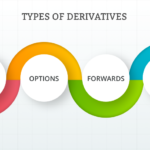Investing in the financial markets offers numerous opportunities for wealth creation, one of which involves the derivatives market. The derivatives market comprises financial instruments like futures, options, swaps, and forward contracts, which derive their value from underlying assets such as stocks, bonds, commodities, and currencies. Along with these tools, investors can consider utilizing a margin trading facility to potentially enhance their strategies and returns. This article delves into the types of derivatives markets and how margin trading can add a new dimension to your investment plan.
Types of Derivatives Market
In the Indian stock market, the derivatives market is broadly categorized into four types:
1. Futures
Futures contracts are agreements to buy or sell an asset at a predetermined price on a specified future date. They are standardized contracts traded on an exchange and represent one of the key types of derivatives market instruments. Futures are popular because they allow traders to leverage their positions, meaning they can control a large amount of the underlying asset with a relatively small capital outlay. Diligently tracking market indicators and trends can make futures trading a viable option for sophisticated investors looking to engage in various forms of the derivatives market.
2. Options
Options are another type of derivative where the buyer has the right, but not the obligation, to buy (call option) or sell (put option) an underlying asset at a predetermined price within a specified period. Options can be used as a hedging tool to mitigate potential losses or as a speculation tool to bet on the future movement of asset prices. The inherent flexibility and ability to strategize different positions make options a versatile instrument in the derivatives market.
3. Swaps
Swaps are derivatives wherein two counterparties exchange financial instruments or cash flows. The most common types are interest rate swaps and currency swaps. In an interest rate swap, one party agrees to pay a fixed rate of interest while receiving a variable rate of interest from another party. These are primarily used to manage interest rate risk or to speculate on changes in future rates. Swaps are usually negotiated over-the-counter (OTC) and cater to specific needs of the counterparties.
4. Forward Contracts
Forward contracts are similar to futures, but they are not standardized or traded on exchanges. These are customized agreements between two parties to buy or sell an asset at a specific price on a future date. While forwards provide flexibility in terms of contract terms, they carry higher counterparty risk compared to exchange-traded derivatives.
Understanding Margin Trading Facility
Margin trading facility allows investors to borrow money from their broker to purchase additional securities. The amount borrowed is called the margin loan, and the broker lends it against the collateral of the initial securities purchased. Through this facility, investors can leverage their positions to amplify potential returns.
How Does Margin Trading Work?
When an investor wants to utilize margin trading, the broker requires an initial margin and then provides the remaining amount to complete the purchase of securities. For instance, if an investor wants to buy shares worth INR 100,000 but has only INR 50,000, they can take a margin loan for the remaining INR 50,000. In this case, the leverage ratio is 2:1.
Here is a detailed example:
- Initial Investment: INR 50,000
- Margin Loan (from broker): INR 50,000
- Total Investment in Securities: INR 100,000
If the value of the securities increases by 20%, the new value becomes INR 120,000.
Profit calculation: INR 120,000 INR 100,000 = INR 20,000
Percent return on initial investment: (INR 20,000 / INR 50,000) * 100 = 40%
In this case, the margin trading facility has doubled the return on investment from 20% to 40%.
Risks Involved with Margin Trading
While margin trading can enhance potential returns, it also magnifies losses. If the price of securities decreases, the investor must still repay the loan with interest, potentially resulting in significant losses. Furthermore, brokers can issue a margin call, requesting the investor to deposit additional funds or sell some of the securities if the value of the collateral drops below a certain level.
Consider an opposing scenario where:
- The securities’ value decreases by 20%,
- Leading their new value to be INR 80,000.
Loss calculation: INR 80,000 INR 100,000 = INR 20,000
Percent loss on initial investment: (INR 20,000 / INR 50,000) * 100 = 40%
Here, the leverage has exacerbated the loss, highlighting the importance of understanding and managing the intrinsic risks of margin trading.
Advantages and Disadvantages of Margin Trading
Advantages
Amplified Returns: With correct market predictions, margin trading can significantly increase returns.
Diversification: Allows acquiring additional securities without liquidating existing holdings.
Hedging: Can be used to hedge against another position to mitigate risks.
Disadvantages
Magnified Losses: Potentially leads to greater losses if market movements are unfavourable.
Margin Calls: Requirement to deposit additional funds or sell securities if the value of the collateral drops.
Interest Costs: Loans carry interest charges, which can reduce overall returns.
Conclusion
The derivatives market offers various financial instruments, each with unique characteristics tailored to different investment strategies. By leveraging tools available in this market, investors can potentially enhance their strategies and returns. However, integrating a margin trading facility into trading strategies should be approached with caution, given the substantial risks involved.
Investors must ensure they gauge all the pros and cons of trading in the Indian stock market and consult professionals if necessary. Understanding the mechanisms, applications, and inherent risks of each instrument is crucial before embarking on such ventures.
—
Disclaimer: Trading in the stock market involves substantial risk. Investors must gauge all the pros and cons of trading in the Indian stock market. It is advisable to consult financial advisors and conduct thorough research before making any investment decisions.

